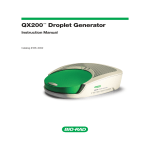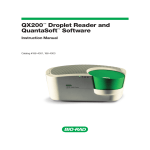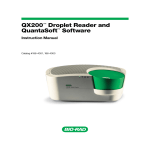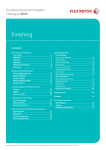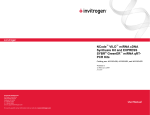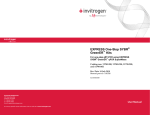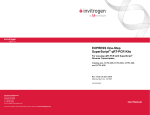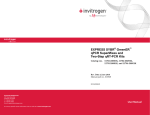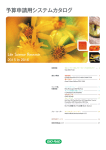Download BIO RAD QX200 Instruction manual
Transcript
QX200™ Droplet Generator Instruction Manual Catalog #186-4002 Preface Bio-Rad Technical Support For help and technical advice, please contact the Bio-Rad Technical Support department. In the United States, the Technical Support department is open Monday–Friday, 5:00 AM–5:00 PM, Pacific time. Phone: 1-800-424-6723 Fax: 1-510-741-5802 Email: [email protected] (for U.S. and international customers) Online technical support and worldwide contact information are available at www.consult.bio-rad.com. Legal Notices No part of this publication may be reproduced or transmitted in any form or by any means, electronic or mechanical, including photocopy, recording, or any information storage or retrieval system, without permission in writing from Bio-Rad Laboratories. Bio-Rad reserves the right to modify its products and services at any time. This instruction manual is subject to change without notice. Although prepared to ensure accuracy, Bio-Rad assumes no liability for errors, or for any damages resulting from the application or use of this information. twin.tec is a trademark of Eppendorf, AG. EvaGreen is a trademark of Biotium, Inc. Bio-Rad Laboratories, Inc. is licensed by Biotium, Inc. to sell reagents containing EvaGreen dye for use in real-time PCR, for research purposes only. Bio-Rad’s thermal cyclers and real-time thermal cyclers are covered by one or more of the following U.S. patents or their foreign counterparts owned by Eppendorf AG: U.S. Patent Numbers 6,767,512 and 7,074,367. This product and/or its use is covered by claims of U.S. patents, and/or pending U.S. and non-U.S. patent applications owned by or under license to Bio-Rad Laboratories, Inc. Purchase of the product includes a limited, non-transferable right under such intellectual property for use of the product for internal research purposes only. No rights are granted for diagnostic uses. No rights are granted for use of the product for commercial applications of any kind, including but not limited to manufacturing, quality control, or commercial services, such as contract services or fee for services. Information concerning a license for such uses can be obtained from Bio-Rad Laboratories. It is the responsibility of the purchaser/end user to acquire any additional intellectual property rights that may be required. Practice of the polymerase chain reaction (PCR) may require a license. Copyright © 2013 by Bio-Rad Laboratories, Inc. All rights reserved. QX200 Droplet Generator Instruction Manual |i Preface Safety and Regulatory Compliance This instrument has been tested and found to be in compliance with all applicable requirements of the following safety and electromagnetic standards: ■■ ■■ IEC 61010-1:2001 (2nd ed.), EN61010-1:2001 (2nd ed). Electrical Equipment for Measurement, Control, and Laboratory Use — Part 1: General requirements EN 61326-1:2006 (Class A). Electrical equipment for measurement, control, and laboratory use. EMC requirements, Part 1: General requirements This equipment generates, uses, and can radiate radiofrequency energy and, if not installed and used in accordance with the instruction manual, may cause harmful interference to radio communications. Operation of this equipment in a residential area is likely to cause harmful interference, in which case the user will be required to correct the interference at his own expense. The CE mark indicates that the manufacturer ensures the product conforms with the essential requirements of the applicable EC directives. The CSA mark indicates that a product, process, or service has been tested to a Canadian or U.S. standard and it meets the requirements of the applicable CSA standard. This equipment has been tested and found to comply with the limits for a Class A digital device pursuant to Part 15 of the FCC Rules. These limits are designed to provide reasonable protection against harmful interference when the equipment is operated in a commercial environment. The Waste Electrical and Electronic Equipment Directive symbol indicates that when the end-user wishes to discard this product, it must be sent to separate collection facilities for recovery and recycling. Instrument Safety Warnings Alteration of this instrument voids the warranty and safety certification and creates a potential safety hazard. This instrument is intended for laboratory use only. Bio-Rad Laboratories is not responsible for any injury or damage caused by use of this instrument for purposes other than those for which it is intended, or by modifications of the instrument not performed by Bio-Rad Laboratories or an authorized agent. Follow the safety specifications listed here and throughout this manual. Use only the power cord supplied with the instrument, using only the plug adaptor that corresponds to the electrical outlets in your region. Use of unapproved supermixes may harm the instrument and voids the warranty. ii| QX200 Droplet Generator Instruction Manual Preface PPE (Personal Protective Equipment) Training Proper use of gloves is recommended with use of oils and sample plates. OSHA requirements for PPE are set forth in the Code of Federal Regulations (CFR) at 29 CFR 1910.132 (General requirements); 29 CFR 1910.138 (Hand protection); 29 CFR 1926.95 (Criteria for standard personal protective equipment). Any gloves with impaired protective ability should be discarded and replaced. Consider the toxicity of the chemicals and factors such as duration of exposure, storage, and temperature when deciding to reuse chemically exposed gloves. Features to aid glove selection for handling of machines, assays, oils, and cleaning solvents: ■■ ■■ ■■ ■■ Butyl gloves are made of a synthetic rubber and protect against peroxide, hydrofluoric acid, strong bases, alcohols, aldehydes, and ketones Natural (latex) rubber gloves are comfortable to wear and feature outstanding tensile strength, elasticity, and temperature resistance Neoprene gloves are made of synthetic rubber and offer good pliability, finger dexterity, high density, and tear resistance; they protect against alcohols, organic acids, and alkalis Nitrile gloves are made of copolymer and provide protection from chlorinated solvents such as trichloroethylene and tetrachloroethene; they offer protection when working with oils, greases, acids, and caustic substances QX200 Droplet Generator Instruction Manual |iii iv| QX200 Droplet Generator Instruction Manual Contents Chapter 1 QX200™ Droplet Generator 1.1 Introduction 1.2 QX200 Droplet Generator 1.3 Installation and General Operation 1 1 2 3 Chapter 2 Droplet Generation 2.1 Sample Preparation 2.2 Operation of the QX200 Droplet Generator 2.3 Preparation for PCR 2.4 Subsequent Steps 5 5 6 10 12 Chapter 3 Specifications and Maintenance 3.1 Specifications 3.2 Maintenance 13 13 14 Appendix A Ordering Information 15 QX200 Droplet Generator Instruction Manual |v vi| QX200 Droplet Generator Instruction Manual 1 QX200™ Droplet Generator 1.1 Introduction The QX200™ Droplet Digital™ PCR (ddPCR™) system performs accurate and precise digital PCR. The system consists of two instruments, the QX200 droplet generator and the QX200 droplet reader, and their associated consumables. The QX200 droplet generator partitions samples into 20,000 nanoliter-sized droplets and, after PCR on a thermal cycler, droplets from each sample are analyzed individually on the QX200 droplet reader. PCR-positive and PCRnegative droplets are counted to provide absolute quantification of target DNA in digital form. Alternatively, amplified products can be extracted from droplets following PCR for downstream applications, such as sequencing or cloning. The ddPCR system lets you: ■■ ■■ ■■ Detect rare DNA target copies with unmatched sensitivity Determine copy number variation with unrivaled accuracy Measure gene expression levels with precision Applications and uses include: ■■■ ■ ■■ ■■ ■■ ■■ Copy number variation Rare sequence detection Gene expression analysis Next-generation sequencing (NGS) library quantification Viral load determination ■■ ■■ ■■ ■■ ■■ ■■ Single cell gene expression analysis Absolute quantification Rare mutant detection miRNA analysis NGS sample preparation GMO detection This manual covers use of the QX200 droplet generator and preparation for PCR. For information on the QX200 droplet reader, please refer to bulletin 10031906. QX200 Droplet Generator Instruction Manual |1 Chapter 1 QX200 Droplet Generator 1.2 QX200 Droplet Generator The QX200 droplet generator uses microfluidics to combine oil and water (sample) to create the droplets required for ddPCR analysis. It generates droplets from up to eight samples at a time in about 2 minutes. Following reaction preparation using the appropriate ddPCR supermix, 20 μl each of up to eight prepared samples (or blanks) and droplet generator oil are transferred to the droplet generator (DG8™) cartridge. The loaded cartridge is covered with a gasket and placed in the QX200 droplet generator. There, the samples and oil are combined within the microchannels of the cartridge to create an emulsion of ~20,000 monodisperse, nanoliter-sized droplets for each of the samples. Following droplet generation, the droplets are transferred to a standard 96-well PCR plate and amplified to end point using a standard thermal cycler. When cycling is complete, the plate is loaded into the QX200 droplet reader. The droplet reader sips each sample, singulates the droplets, and streams them in single file past a two-color detector. The detector reads each droplet and determines which contain a target (+) and which do not (–). If quantitation of droplets is not required, PCR products can be extracted from droplets following thermal cycling for downstream applications, such as sequencing or cloning. The QX200 droplet generator includes the components listed in Table 1.1. Additional requirements for droplet generation and PCR are listed in Table 1.2. For complete system requirements, refer to the QX200 Droplet Reader Instruction Manual (bulletin 10031906). Table 1.1. QX200 droplet generator components. Catalog # refers to replacement items (quantities may be different). Component Description Catalog # QX200 droplet generator Instrument used for droplet generation 186-4002 DG8 droplet generator cartridges and gaskets (24) Microfluidic cartridge used to mix sample and oil to generate droplets; gaskets seal the cartridge to prevent evaporation and apply pressure required for droplet formation 186-4007 Droplet generator cartridge holder Positions and holds the droplet generator cartridge in the instrument for droplet generation 186-3051 Power cord Connects QX200 droplet generator to power source Call technical support QX200 droplet generator. 2| QX200 Droplet Generator Instruction Manual Chapter 1 QX200 Droplet Generator Table 1.2. Additional materials required for droplet generation. Component Recommended Catalog # Reagents for probe detection ddPCR supermix for probes PCR supermix 186-3010, 186-3026, 186-3027, 186-3028 Droplet PCR supermix 186-3023, 186-3024, 186-3025 One-Step RT-ddPCR supermix for probes 186-3021, 186-3022 Droplet generator oil Droplet generator oil for probes 186-3030, 186-3005 Control ddPCR buffer control kit for probes 186-3052 Reagents for EvaGreen detection PCR supermix QX200™ ddPCR™ EvaGreen® supermix 186-4033, 186-4034, 186-4035, 186-4036 Droplet generator oil QX200 droplet generator oil for EvaGreen dye 186-4005, 186-4006 Control QX200 buffer control kit for EvaGreen dye 186-4052 Consumables and other materials 20 μl pipet for sample loading Pipets Rainin L-20 50 μl pipet for droplet transfer Rainin L-50, L8-50 8-channel, 200 μl pipet for oil Rainin L8-200 Pipet tips Filtered Rainin GP-L10F, GP-L200F 96-well PCR plates twin.tec semi-skirted 96-well plate Eppendorf 951020362 Reagent trough Any Foil plate seals Pierceable foil plate seals 181-4040 Plate sealer PX1™ PCR plate sealer 181-4000 8-cap strips Any 1.3 Installation and General Operation ■■ Connect the QX200 droplet generator to a power source using only the power cord provided. Ensure the ground is reliably connected before plugging in the instrument ■■ Leave 10" (5 cm) clear space behind and 5" (2.5 cm) clear to the right and left for proper ventilation ■■ Power on the droplet generator by plugging it in. The status indicator turns solid green to indicate power is on ■■ Open and close the instrument by pressing the button on top of the green lid U.S. standard power cord set with grounded plug (Type 5-15P) and C5 connector (10 A/125 V) Power supply to 5 mm DC power jack inlet QX200 Droplet Generator Instruction Manual |3 Chapter 1 QX200 Droplet Generator 4| QX200 Droplet Generator Instruction Manual 2 Droplet Generation 2.1 Sample Preparation Prepare the PCR reaction by combining 2x PCR supermix, 20x primers and probe, and DNA sample. Mix by vortexing in short pulses; centrifuge briefly. ■■ ■■ ■■ ■■ ■■ ■■ The concentration of intact human genomic DNA should be <66 ng per 20 µl reaction. If using higher concentrations, digest DNA with a restriction endonuclease that does not cut target or reference amplicons Use one of the PCR supermixes recommended in Table 1.2, as these contain reagents required for droplet generation. Follow instructions in the product inserts to prepare the samples for droplet generation Vortex the supermixes thoroughly to ensure homogeneity, as a concentration gradient may form during –20°C storage. Alternatively, pipet up and down >5 times to mix. Centrifuge briefly to collect contents at the bottom of the tube before dispensing Thaw and equilibrate reaction components to room temperature. If the sample is prone to thermal degradation, prepare the reaction mix on ice, but equilibrate the reaction mix to room temperature (~3 min) before loading into the DG8™ cartridge for droplet formation Assemble reaction mixtures in vials or in 96-well PCR plates. The advantage of using a PCR plate is that samples can be loaded into the DG8 cartridge using an 8-channel pipet Use standard lab precautions to avoid contamination of the reaction mix and sample: wear gloves, work in a clean area (such as a PCR hood), and use clean pipets and low protein binding tubes QX200 Droplet Generator Instruction Manual |5 Chapter 2 Droplet Generation 2.2 Operation of the QX200™ Droplet Generator The QX200 droplet generator prepares droplets for up to eight samples at a time. Droplet generation takes ~2 minutes for each set of eight samples (~30 minutes for a 96-well plate). ■■ ■■ All 8 sample wells in the DG8 droplet generator cartridge must contain sample (or 1x buffer control), and all 8 oil wells must contain droplet generator oil Do not load sample or oil into the DG8 cartridge unless it is inserted in the holder 1. Insert the DG8 cartridge into the holder with the notch in the cartridge at the upper left of the holder: a. Open the cartridge holder by pressing the latches in the middle. b. Slide the DG8 cartridge into the right half of the holder, then drop it down. Notch Top wells (droplets) Middle wells (20 μl sample) Bottom wells (70 μl oil) DG8 cartridge c. Press the halves of the holder together to snap it closed. Press to open Press Inserting the DG8 cartridge into the cartridge holder. 6| QX200 Droplet Generator Instruction Manual Slide to close Chapter 2 Droplet Generation 2. Transfer 20 μl of each prepared sample to the sample wells (middle row) of the DG8 cartridge. Air bubbles can cover the bottom of the well and result in 2,500–7,000 fewer droplets and poor data quality. They are difficult to see. To avoid creating air bubbles, use the following pipetting technique, which also ensures samples wet the bottoms of the wells so they are wicked into the microchannels (necessary for proper droplet generation). ■■ ■■ ■■ Use only 20 μl aerosol-barrier (filtered) Rainin pipet tips; do not use 200 μl pipet tips (see Table 1.2) Gently slide the pipet tip down the side of the well at a ~15° angle until it passes over the ridge near the bottom. Holding the angle, ground the pipet tip against the bottom edge of the sample well while slowly dispensing a small portion of the sample; do not pipet directly onto the side (wall) of the well After dispensing about half the sample, slowly draw the tip up the wall while dispensing the rest of the sample; do not push the pipet plunger past the first stop 15° angle Tip Ridge in well Transferring sample to the sample wells (middle row) of the DG8 cartridge. Hold the pipet tip at a 15° angle and at the bottom of the well (middle and right panels); do not dispense sample onto the wall or side of the well. 3. Dispense the droplet generator (DG) oil in the reagent trough (see Table 2.1 for volumes required; see Table 1.2 for PCR supermix and DG oil compatability). Table 2.1. Droplet generator (DG) oil requirements. # Wells Volme of Oil 8 700 μl 24 1,820 μl 48 3,500 μl 96 6,860 μl Reagent trough and droplet generator oil. QX200 Droplet Generator Instruction Manual |7 Chapter 2 Droplet Generation 4. Using a multichannel pipet, fill each oil well (bottom row) with 70 μl DG oil from the reagent trough. Filling the oil wells with droplet generator oil. 5. Hook the gasket over the cartridge holder using the holes on both sides. The gasket must be securely hooked on both ends of the holder; otherwise, pressure sufficient for droplet generation will not be achieved. Correct placement of the gasket over the cartridge holder. 6. Open the QX200 droplet generator by pressing the button on the green top and place the cartridge holder into the instrument. When the holder is in the correct position, both the power (left light) and holder (middle light) indicator lights are green (see Table 2.2) 7. Press the button on the top again to close the door. This initiates droplet generation: a manifold positions itself over the outlet wells, drawing oil and sample through the microfluidic channels, where droplets are created. Droplets flow to the droplet well, where they accumulate. The droplet indicator light (at right) flashes green after 10 sec to indicate droplet generation is in progress. 8| QX200 Droplet Generator Instruction Manual Chapter 2 Droplet Generation Press to open and close Status indicator lights QX200 droplet generator with DG8 cartridge in place. 8. When droplet generation is complete, all three indicator lights are solid green. Open the door by pressing the button, and remove the holder (with DG8 cartridge still in place) from the unit. Remove the disposable gasket from the holder and discard it. The top wells of the cartridge contain droplets, and the middle and lower wells are nearly empty with a small amount of residual oil. Keep the DG8 cartridge in the holder. Table 2.2. Status indicator lights on the QX200 droplet generator. If the central LED flashes amber, the gasket is not placed on the holder correctly or is missing and no seal was made. If the right LED flashes amber, a process error occurred because the volume is too low in at least one well. Power on DG8 cartridge holder in place Run complete Flashing green — — Run in progress Flashing amber — No seal; no gasket or empty well Low volume in well Power off No DG8 cartridge holder Idle Solid green Off QX200 Droplet Generator Instruction Manual |9 Chapter 2 Droplet Generation 2.3 Preparation for PCR 1. Pipet 40 μl of the contents of the top wells (the droplets) into a single column of a 96-well PCR plate. Use the following pipetting techniques to avoid shearing or coalescing the droplets: To aspirate droplets from the DG8 cartridge: ■■ ■■ ■■ ■■ Use an 8-channel manual L-50 pipet with 200 µl tips (not wide- or narrow-bore) Place the cartridge holder on a flat surface and position the pipet tips in each of the 8 top wells at a ~30–45° angle, vertical into the junction where the side wall meets the bottom of the well. Do not position the pipet tip in a vertical orientation (90°) or against any flat surface of the well; do not allow the tips to be flat against the bottoms of the wells Slowly draw 40 µl of droplets into the pipet tip (should take ~5 sec, and ~5 µl air is expected); do not aspirate >40 µl, as this causes air to percolate through the droplets Pipet slowly. Apply a stable resistive force to the plunger to draw and aspirate droplets smoothly into and out of pipet tips To dispense droplets into the 96-well plate, position the pipet tip along the side of the well — near, but not at, the bottom of the well — and slowly dispense the droplets (~5 sec). To prevent evaporation and contamination with particulates, cover the plate (for example, with 8-cap strips or the lid from a pipet tip box) as you work. Aspirating droplets from the DG8 cartridge. 10| QX200 Droplet Generator Instruction Manual Dispensing droplets into a 96-well PCR plate. Chapter 2 Droplet Generation 2. Seal the PCR plate with foil immediately after transferring droplets to avoid evaporation. Use pierceable foil plate seals that are compatible with the PX1™ PCR plate sealer and the needles in the QX200 droplet reader (for example, catalog #181-4040). Follow the instructions in the PX1 PCR Plate Sealer Instruction Manual (bulletin 10023997). a. Set the plate sealer temperature to 180°C and time to 5 sec. b. Touch the arrow to open the PX1 tray door. Position the support block on the tray with the 96-well side facing up. Place the 96-well plate onto the support block and ensure that all plate wells are aligned with the support block. c. Cover the 96-well plate with one sheet of pierceable foil seal. (The yellow label on the Bio-Rad heat seal bag identifies the sealing surface.) Do not attempt to place the frame over the foil-covered plate. The frame is only for use with other seals. d. Once the 96-well plate is secured on the support block and covered with the pierceable foil seal, touch the seal button. The tray will close and heat sealing will initiate. e. When heat sealing is complete, the PX1 door opens automatically. Remove the plate from the block for thermal cycling. Remove the block from the PX1. f. Check that all the wells in the plate are sealed; the depressions of the wells should be visible on the foil. Once sealed, the plate is ready for thermal cycling. 3. Once droplets are removed, press the latches on the DG8 cartridge holder to open it. Remove the empty DG8 cartridge and discard it. Begin thermal cycling (PCR) within 30 min of sealing the plate, or store the plate at 4°C for up to 4 hr prior to thermal cycling. Refer to the supermix product inserts for cycling conditions. PX1 PCR plate sealer (left) and a sealed 96-well plate (right). QX200 Droplet Generator Instruction Manual |11 Chapter 2 Droplet Generation 2.4 Subsequent Steps Once the 96-well plate containing the droplets is sealed, place it into the thermal cycler for PCR amplification. Refer to the supermix product inserts for cycling conditions. When PCR amplification is complete, remove the 96-well plate from the thermal cycler and read the droplets using the QX200 droplet reader (follow the instructions in the QX200 Droplet Reader Instruction Manual, bulletin 10031906). If the goal is to read or quantify droplets and recover material from droplets in parallel, prepare two sets of reactions, one for each application. For example, a set of eight wells in a single DG8 cartridge can be generated: four of these will be read after thermal cycling, and four will not be read. Refer to the QX200 Droplet Reader Instruction Manual (bulletin 10031906) for more details. 12| QX200 Droplet Generator Instruction Manual 3 Specifications and Maintenance 3.1 Specifications 5 inches (127 mm) 11 inches (279 mm) 14 inches (356 mm) Weight 10 lb. (4.5 kg) Size (W x D x H) 11 x 14 x 5" (28 x 36 x 13 cm) Electrical requirements 100–240 V, 50/60 Hz, 60 W; voltage fluctuations not to exceed +10% of ratings Temperature15–30ºC Altitude 0–6,560 ft (0–2,000 m) Humidity 85% max (noncondensing) Pollution degree 2 (indoor use) II (external power supply plugs into standard AC Installation category receptacle) Ventilation requirement 5" (12 cm) left and right of machine and 10" (25 cm) behind should be unobstructed for proper ventilation QX200 Droplet Generator Instruction Manual |13 Chapter 3 Specifications and Maintenance 3.2 Maintenance Surfaces of the instrument may require general cleaning. Use deionized/distilled water for general wipe down with a slightly dampened cloth. For decontamination, 10% bleach followed by 70% ethanol and/or deionized/ distilled water may be used. Do not use acetone or tap water. Inspect equipment regularly for damaged external components or wiring. Do not use if damaged. Apply standard MSDS (Material Safety Data Sheet) and OSHA practices when handling and disposing of generated waste. Bio-Rad droplet generation and reader fluids are based on fluorinated hydrocarbon chemistry and should be disposed of in accordance with institutional, state, and local regulations. These nonflammable fluids are inert and have low environmental impact and low toxicity. Collect waste in a polyethylene container and discard within one month. Droplets made with Bio-Rad master mix have antimicrobial properties, but microbial growth is possible. The waste profile should contain the following: fluorinated hydrocarbons, water, fluorescent dye (from probes), intercalating dye, protein, and nucleic acids. The droplet generator is not intended to be used with biohazardous material. 14| QX200 Droplet Generator Instruction Manual Appendix A Ordering Information QX200™ ddPCR™ System 186-3030 Catalog # 186-4001 Droplet Generator Oil for Probes, 2 x 7 ml 186-3005 Droplet Generator Oil for Probes, 10 x 7 ml 186-4005 Droplet Generator Oil for EvaGreen Dye, 2 x 7 ml 186-4006 Droplet Generator Oil for EvaGreen Dye, 10 x 7 ml 186-3031 Droplet Reader Oil, 1 x 1 L 186-3004 Droplet Reader Oil, 2 x 1 L 186-4002 186-4003 186-4007 Description QX200™ Droplet Digital™ PCR System, includes droplet generator, droplet reader, laptop computer, software, associated component consumables QX200 Droplet Generator, includes droplet generator, 1 box of 24 cartridges, 1 pkg of 24 gaskets, 2 cartridge holders, 1 power cord QX200 Droplet Reader, includes droplet reader, ddPCR manual, 2 plate holders, USB cable, power cord ddPCR Reagents 186-3026 Droplet Generator Cartridges and Gaskets, includes 5 pkg of 24 DG8™ cartridges, 5 pkg of 24 DG8 gaskets ddPCR Supermix for Probes, 2 ml (2 x 1 ml), 2x supermix 186-3010 ddPCR Supermix for Probes, 5 ml (5 x 1 ml), 2x supermix 186-3027 ddPCR Supermix for Probes, 25 ml (5 x 5 ml), 2x supermix 186-3028 ddPCR Supermix for Probes, 50 ml (10 x 5 ml), 2x supermix 186-3023 Droplet PCR Supermix, 2 ml (2 x 1 ml), 2x supermix 186-3024 Droplet PCR Supermix, 5 ml (5 x 1 ml), 2x supermix 186-3025 Droplet PCR Supermix, 25 ml (5 x 5 ml), 2x supermix 186-4008 DG8 Cartridges for QX100™/QX200 Droplet Generator, 1 pkg of 24 cartridges 186-3009 DG8 Gaskets for QX100/QX200 Droplet Generator, 1 pkg of 24 gaskets 186-3051 DG8 Cartridge Holder 510-10608 Droplet Reader Plate Holder QX200 Droplet Generator Instruction Manual |15 Appendix A Ordering Information 186-3021 186-3022 One-Step RT-ddPCR Kit for Probes, 2 ml (2 x 1 ml), 200 x 20 µl reactions, 2x RT-ddPCR mix, includes 1 manganese acetate tube One-Step RT-ddPCR Kit for Probes, 5 ml (5 x 1 ml), 500 x 20 µl reactions, 2x RT-ddPCR mix, includes 2 manganese acetate tubes 186-4033 QX200™ ddPCR™ EvaGreen® Supermix, 2 ml (2 x 1 ml), 200 x 20 µl reactions 186-4034 QX200 ddPCR EvaGreen Supermix, 5 ml (5 x 1 ml), 500 x 20 µl reactions 186-4035 QX200 ddPCR EvaGreen Supermix, 25 ml (5 x 5 ml), 2,500 x 20 µl reactions 186-4036 QX200 ddPCR EvaGreen Supermix, 50 ml (10 x 5 ml), 5,000 x 20 µl reactions 186-3052 ddPCR Buffer Control Kit for Probes, 2 x 4.5 ml bottles, 2x buffer 186-4052 ddPCR Buffer Control Kit for EvaGreen, 2 x 4.5 ml bottles, 2x buffer 16| QX200 Droplet Generator Instruction Manual Thermal Cycler and Plate Sealer 185-1196 C1000 Touch™ Thermal Cycler with 96-Well Fast Reaction Module, includes C1000 Touch thermal cycler chassis, 96-well fast reaction module, USB flash drive 181-4000 PX1™ Plate Sealer, includes heat sealing instrument, plate support block that holds 96-well and 384-well plates, sealing frame, power cord Bio-Rad Laboratories, Inc. Web site www.bio-rad.com USA 800 424 6723 Australia 61 2 9914 2800 Austria 01 877 89 01 Belgium 09 385 55 11 Brazil 55 11 5044 5699 Canada 905 364 3435 China 86 21 6169 8500 Czech Republic 420 241 430 532 Denmark 44 52 10 00 Finland 09 804 22 00 France 01 47 95 69 65 Germany 089 31 884 0 Greece 30 210 9532 220 Hong Kong 852 2789 3300 Hungary 36 1 459 6100 India 91 124 4029300 Israel 03 963 6050 Italy 39 02 216091 Japan 03 6361 7000 Korea 82 2 3473 4460 Mexico 52 555 488 7670 The Netherlands 0318 540666 New Zealand 64 9 415 2280 Norway 23 38 41 30 Poland 48 22 331 99 99 Portugal 351 21 472 7700 Russia 7 495 721 14 04 Singapore 65 6415 3188 South Africa 27 861 246 723 Spain 34 91 590 5200 Sweden 08 555 12700 Switzerland 026 674 55 05 Taiwan 886 2 2578 7189 Thailand 800 88 22 88 United Kingdom 020 8328 2000 Life Science Group 10031907 Rev A US/EG 13-1048 0713 Sig 1212




























